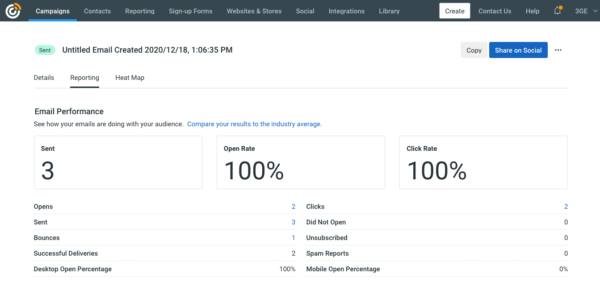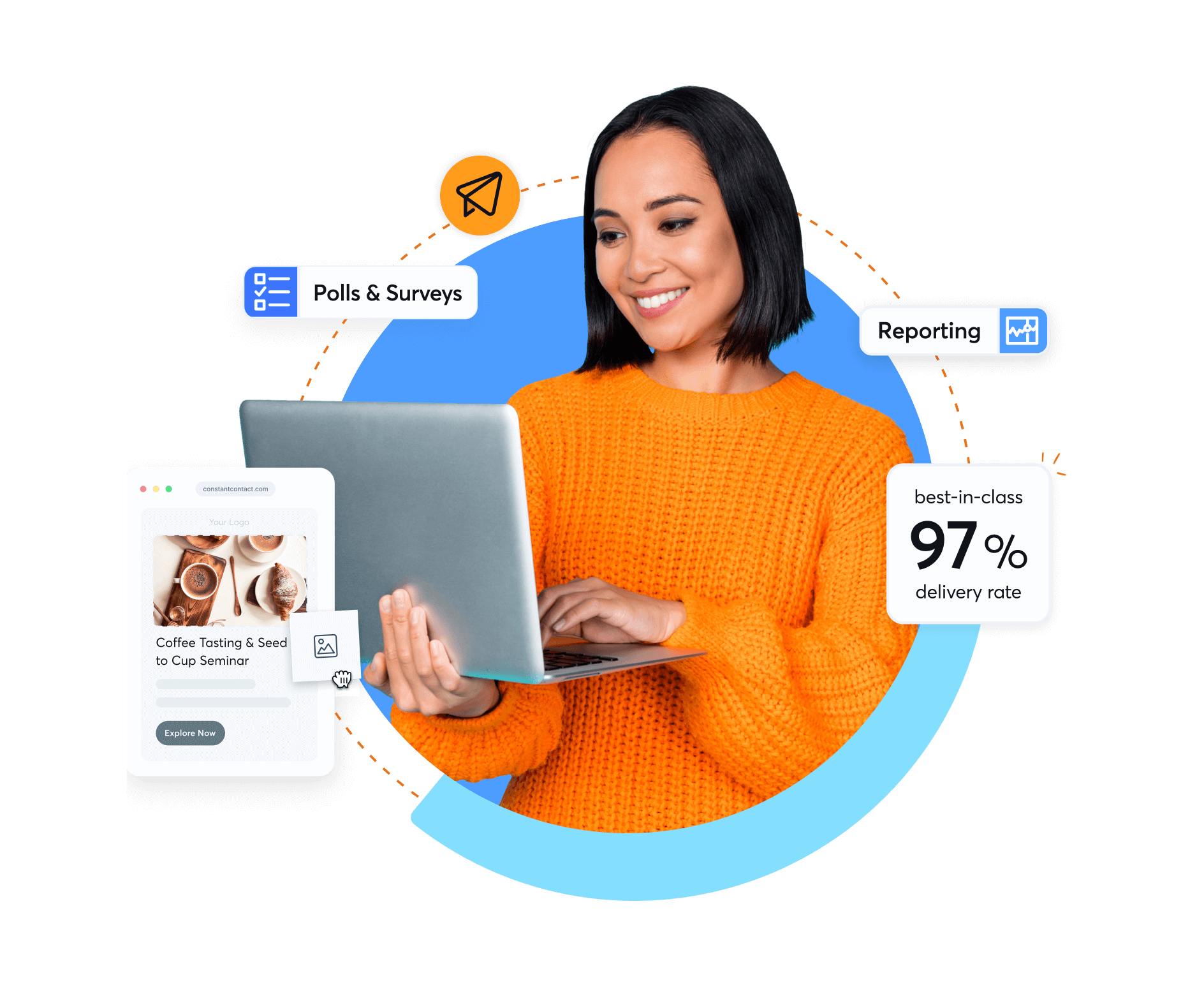The best time to send Constant Contact emails is typically between 10 AM and 11 AM or 1 PM and 3 PM. These time slots often yield higher open and engagement rates.
Understanding the optimal time to send emails can significantly impact your marketing success. Timing influences when recipients are most likely to check their inboxes. Late mornings and early afternoons often align with common work routines, making them prime for engagement.
Testing different times can also help you tailor your strategy to your audience’s habits. Analyzing open rates and click-through rates will refine your approach, ensuring your emails achieve their intended goals. By optimizing your sending times, you enhance visibility and foster stronger connections with your audience.

Credit: www.constantcontact.com
Introduction To Email Timing
Timing is key in email marketing. The right moment can boost open rates. This section explores the best times to send emails using Constant Contact.
The Importance Of Timing
Email timing affects engagement. Sending emails at the wrong time can lead to low open rates. Here are some key points on why timing matters:
- Higher Open Rates: Emails sent at optimal times get noticed.
- Improved Click-Through Rates: Recipients are more likely to engage.
- Better Conversion Rates: Timing can lead to more sales.
Understanding your audience’s habits is crucial. Analyze when your subscribers are most active.
Overview Of Constant Contact
Constant Contact is a popular email marketing tool. It helps businesses manage and send emails easily. Here are some features:
| Feature | Description |
|---|---|
| Templates | User-friendly designs for all occasions. |
| Analytics | Track open rates and engagement. |
| Segmentation | Target specific groups of subscribers. |
| A/B Testing | Test different email versions for better results. |
Using these features can enhance your email timing strategy. Constant Contact makes it easy to analyze data.

Credit: www.constantcontact.com
Analyzing Your Audience
Understanding your audience is key to effective email marketing. Knowing their preferences helps you choose the best time to send emails. This analysis boosts engagement and improves response rates.
Segmentation Strategies
Segmenting your audience is crucial. It allows you to tailor your messages. Here are some effective segmentation strategies:
- Demographics: Age, gender, and location.
- Purchase history: Previous buying behaviors.
- Engagement level: Active versus inactive subscribers.
- Interests: Topics they care about.
By dividing your audience, you can send targeted emails. This increases the chances of your emails being opened and read.
Understanding Recipient Behavior
Analyzing recipient behavior is essential. Here are some factors to consider:
- Open rates: Track when emails are opened.
- Click-through rates: See which links get clicked.
- Time spent reading: Measure how long they engage.
Utilize analytics tools for insights. These metrics guide you on the best sending times. Tailor your strategy based on this data to maximize engagement.
Industry Trends And Timing
Choosing the right time to send emails can boost engagement. Industry trends show clear patterns in email open rates. Understanding these trends helps optimize your email campaigns. Timing can vary based on the industry. Below are key insights to guide your decisions.
General Best Practices
Timing plays a critical role in email effectiveness. Here are some general best practices:
- Mid-week: Tuesday, Wednesday, and Thursday often yield higher open rates.
- Morning hours: Sending emails between 9 AM and 11 AM captures attention.
- After lunch: Emails sent between 1 PM and 3 PM are also effective.
Consider these factors for optimal timing:
- Know your audience’s time zone.
- Track past email performance.
- A/B test different sending times.
Industry-specific Insights
Different industries have unique email timing trends. Here’s a breakdown:
| Industry | Best Sending Days | Best Sending Times |
|---|---|---|
| Retail | Thursday, Friday | 10 AM, 2 PM |
| Technology | Tuesday, Wednesday | 9 AM, 1 PM |
| Healthcare | Monday, Wednesday | 11 AM, 3 PM |
| Education | Tuesday, Thursday | 10 AM, 1 PM |
Monitor these trends. Adjust your strategy based on your audience’s habits. A tailored approach leads to better results.
The Role Of Time Zones
Understanding time zones is crucial for email marketing success. Sending emails at the right time increases open rates. Ignoring time zones can lead to missed opportunities.
Global Reach Considerations
Your audience may span multiple time zones. Consider these factors:
- Geographic location of your subscribers
- Peak engagement times in different regions
- Local holidays and events
Analyze your email list. Identify where most of your subscribers reside. This helps determine the best time to send emails.
Time Zone Targeting Techniques
Use these techniques to optimize your email timing:
- Segment your audience by time zone.
- Send emails at local times for each segment.
- Utilize email tools that support time zone scheduling.
For example, a subscriber in New York receives the email at 10 AM. A subscriber in Los Angeles gets it at 7 AM. This increases the chance of engagement.
| Time Zone | Best Time to Send |
|---|---|
| EST (New York) | 10 AM |
| CST (Chicago) | 9 AM |
| MST (Denver) | 8 AM |
| PST (Los Angeles) | 7 AM |
Targeting specific time zones boosts open rates. Tailoring your emails increases relevance. Pay attention to your audience’s habits and preferences.
Weekday Vs. Weekend
Choosing the right time to send emails can impact your engagement rates. Weekdays and weekends each have their advantages and drawbacks. Understanding these can help you make informed decisions.
Pros And Cons
| Day | Pros | Cons |
|---|---|---|
| Weekdays |
|
|
| Weekends |
|
|
Case Studies
Several studies show different results based on industries and audiences.
- Retail Brands: Emails sent on weekends saw a 20% higher open rate.
- B2B Companies: Weekday emails had a 30% better click-through rate.
- Nonprofits: Weekend campaigns boosted donations by 25%.
Testing is key. Analyze your audience’s habits. Adjust your strategy based on their responses.
Testing And Optimization
Finding the best time to send emails is essential. Testing and optimization help improve engagement rates. Use A/B testing to identify what works best. Analyze results to refine your email strategy.
A/b Testing Strategies
A/B testing allows you to compare two email versions. Here are some effective strategies:
- Send Time: Test different times of day.
- Subject Lines: Experiment with various subject lines.
- Content: Vary the email content to see what resonates.
- Call-to-Action: Test different CTAs to boost clicks.
Run tests for a specific audience segment. Keep the test duration consistent. Track results to make informed decisions.
Analyzing And Acting On Results
Once you have results, analyze them thoroughly. Follow these steps:
- Identify Trends: Look for patterns in open and click rates.
- Compare Data: Use tools to compare A/B test data.
- Adjust Timing: Optimize send times based on data.
- Implement Changes: Use successful strategies in future campaigns.
Document findings for future reference. Continually test and adapt your email strategy. This will lead to better engagement and results.
Leveraging Analytics
Analytics play a crucial role in optimizing your email campaigns. They help you identify the best time to send emails. By analyzing data, you can improve open rates and engagement. Understanding your audience’s behavior makes a significant difference.
Key Metrics To Watch
Focusing on the right metrics helps refine your email strategy. Here are some key metrics to monitor:
- Open Rate: Percentage of recipients who opened your email.
- Click-Through Rate (CTR): Percentage of recipients who clicked links.
- Conversion Rate: Percentage of recipients who completed a desired action.
- Unsubscribe Rate: Percentage of recipients who opted out.
Each of these metrics provides insight into how your emails perform. Use this data to adjust send times and content.
Tools And Platforms
Many tools help track and analyze email performance. Here are some popular options:
| Tool | Features |
|---|---|
| Google Analytics | Track website traffic from email campaigns. |
| Mailchimp | Offers detailed reports and analytics. |
| Constant Contact | Provides insights on email performance. |
| HubSpot | Integrates email performance with CRM data. |
These tools simplify tracking and analyzing your email campaigns. They help you make informed decisions about the best times to send emails.

Credit: www.constantcontact.com
Advanced Strategies
Maximize your email success with advanced strategies. Smart timing boosts engagement and opens. Use data-driven methods for optimal results.
Automated Send-time Optimization
Automated send-time optimization helps you reach your audience effectively. It adjusts the timing of your emails based on user behavior. Here’s how it works:
- Analyzes past engagement data.
- Identifies peak open times for subscribers.
- Schedules emails for maximum impact.
Benefits of this approach include:
- Increased open rates.
- Higher click-through rates.
- Enhanced overall engagement.
Integrating Ai For Better Timing
Artificial Intelligence (AI) revolutionizes email timing. It learns from subscriber interactions to optimize send times. Consider these key points:
| AI Benefit | Description |
|---|---|
| Personalized Timing | AI customizes send times for individual users. |
| Real-time Adjustments | AI adapts to current trends and user activity. |
| Improved Metrics | AI tracks performance to refine strategies. |
Integrating AI leads to:
- More targeted communication.
- Enhanced customer satisfaction.
- Increased conversion rates.
Embrace these advanced strategies to improve your email campaigns.
Frequently Asked Questions
What Is The Best Time To Send Emails?
The best time to send emails typically falls between 10 AM and 2 PM on weekdays. This window captures recipients when they are most engaged. Avoid early mornings and late afternoons to maximize open rates and responses.
When Should I Avoid Sending Emails?
It’s best to avoid sending emails on Mondays and Fridays. On Mondays, people are catching up from the weekend. Fridays often see reduced engagement as people prepare for the weekend. Midweek, especially Tuesday to Thursday, tends to yield better results.
How Does Audience Influence Email Timing?
Your audience’s behavior significantly impacts the best sending time. Consider their time zone, industry, and daily routines. Tailoring your email schedule based on these factors can enhance engagement rates and improve overall campaign success.
What Days Are Best For Email Marketing?
Tuesday, Wednesday, and Thursday are generally the best days for email marketing. These days see higher open rates and engagement compared to Mondays and Fridays. Aim to schedule your emails during these midweek days for optimal results.
Conclusion
Choosing the right time to send your Constant Contact emails can significantly boost engagement. Analyze your audience’s habits for optimal results. Testing different times can reveal what works best. By applying these insights, you can enhance your email marketing strategy and increase your open rates effectively.
Start experimenting today!

